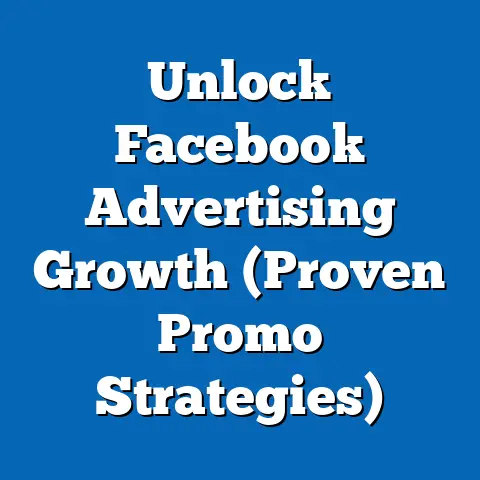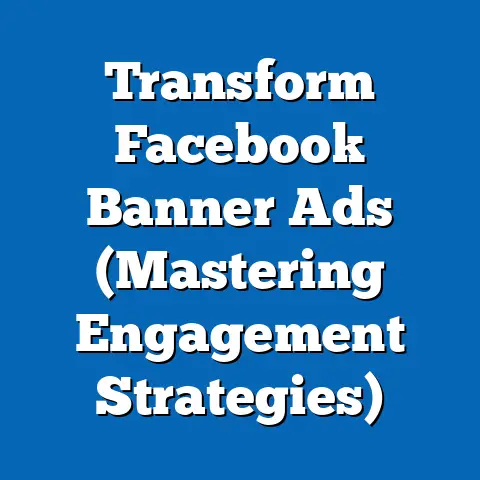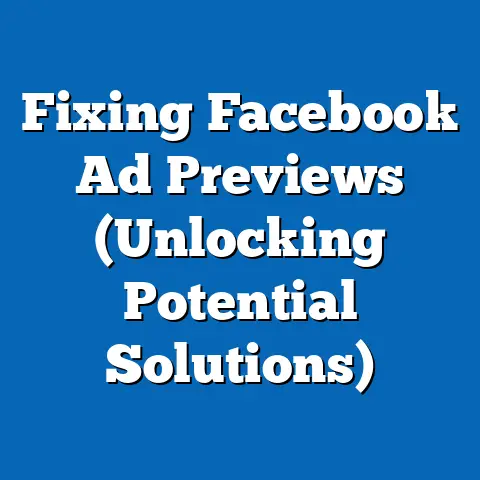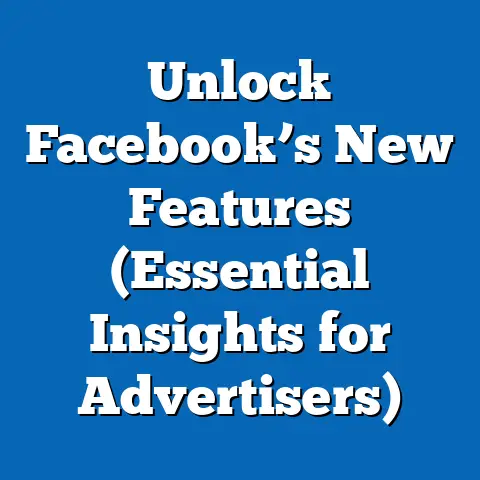Drive Sales with Blogs vs. Facebook Ads (Insightful Comparison)
Our goal is to present objective findings that highlight the strengths and limitations of each platform in reaching target audiences and driving measurable sales outcomes. Data is sourced from Pew Research Center surveys, industry reports, and third-party analytics platforms to ensure accuracy and relevance. This analysis covers trends from 2020 to 2023, with projections where applicable, to provide a current and forward-looking perspective.
Section 1: Accessibility and Reach
1.1 Blogs: Accessibility and User Engagement
Blogs remain a widely accessible digital marketing tool due to their low entry barriers for both creators and consumers. As of 2023, approximately 77% of internet users globally read blogs regularly, according to a survey by Orbit Media Studios, with 43% of these readers accessing content via mobile devices. This represents a 5% increase in mobile blog readership since 2021, reflecting the growing importance of mobile-optimized content.
Accessibility is further enhanced by the diversity of blogging platforms such as WordPress, which powers 43% of all websites as of 2023 (W3Techs). Small businesses and individual entrepreneurs can create blogs with minimal investment, often under $100 annually for hosting and domain costs. However, reaching a broad audience requires consistent content creation and search engine optimization (SEO), with 68% of blog traffic originating from organic search (HubSpot, 2023).
1.2 Facebook Ads: Accessibility and Platform Reach
Facebook Ads offer unparalleled accessibility in terms of audience reach, with Meta reporting 2.11 billion daily active users on Facebook as of Q3 2023. This represents a 7% year-over-year increase from 1.97 billion in Q3 2022. The platform’s advertising tools are accessible to businesses of all sizes, with ad campaigns starting at just $1 per day, though effective campaigns often require budgets of $5–$10 daily for small businesses (Meta Business Suite, 2023).
Accessibility is also supported by advanced targeting options, allowing advertisers to reach specific demographics based on age, location, interests, and behaviors. Approximately 98% of Facebook users access the platform via mobile devices, making mobile-first ad design critical. However, ad fatigue is a noted challenge, with 26% of users reporting annoyance with repetitive ads in a 2022 Pew Research Center survey.
1.3 Comparative Accessibility
Blogs offer greater accessibility for long-term, low-cost engagement, as they do not require ongoing ad spend and can build organic traffic over time. In contrast, Facebook Ads provide immediate reach to a vast audience but require consistent financial investment, with average costs per click (CPC) rising 14% from $0.97 in 2022 to $1.11 in 2023 (WordStream). While blogs depend on content quality and SEO for visibility, Facebook Ads leverage algorithmic targeting for precision, though at a higher short-term cost.
Section 2: Demographic Breakdowns
2.1 Blogs: Audience Demographics
Blog readership spans a wide demographic range, with distinct patterns by age, gender, and income level. According to a 2023 Statista report, 54% of blog readers are aged 25–44, with 29% aged 18–24 and 17% over 45. Gender distribution is relatively balanced, with 52% female and 48% male readers.
Income levels also influence blog engagement, with 41% of readers earning between $50,000 and $100,000 annually, compared to 23% earning less than $50,000. Educational attainment is another key factor, as 62% of blog readers have at least a bachelor’s degree, suggesting blogs resonate with a more educated audience (Orbit Media Studios, 2023). Regionally, urban readers account for 58% of blog traffic, compared to 42% from suburban and rural areas.
2.2 Facebook Ads: Audience Demographics
Facebook’s user base is similarly diverse, but with different engagement patterns for ads. As of 2023, 31% of Facebook users are aged 25–34, the largest single age group, followed by 18–24 (26%) and 35–44 (18%) (Statista, 2023). Gender distribution shows a slight male skew, with 56% male and 44% female users globally.
Income demographics for ad engagement reveal that 38% of users targeted by ads fall into the $30,000–$75,000 income bracket, with 22% earning above $75,000. Educational data indicates that 49% of users have some college education or higher, though this varies by region. Geographically, 69% of Facebook ad impressions occur in urban areas, with significant growth in ad reach in developing regions, up 12% year-over-year in Asia-Pacific markets (Meta Ad Insights, 2023).
2.3 Comparative Demographic Reach
Blogs tend to attract a slightly older and more educated audience, with stronger engagement among middle-income groups. Facebook Ads, however, excel in reaching younger users (18–34), with broader geographic penetration, particularly in urban centers. While blogs build trust with niche, informed audiences, Facebook Ads offer scalability across diverse demographics, though ad relevance can vary widely by age and income group.
Section 3: Trend Analysis
3.1 Blogs: Usage and Performance Trends
Blogging as a sales driver has seen steady growth, with 55% of marketers reporting blogs as their top content marketing priority in 2023, up from 50% in 2021 (Content Marketing Institute). Conversion rates for blog-driven leads average 6%, compared to 2% for general website traffic, reflecting blogs’ effectiveness in nurturing prospects (HubSpot, 2023). Year-over-year, blog traffic from organic search grew by 8% between 2022 and 2023, driven by increased Google algorithm emphasis on quality content.
However, challenges include longer lead times, with 62% of businesses reporting it takes 3–6 months to see significant traffic from new blog content. Additionally, engagement metrics show a decline in average time spent on blogs, dropping from 3.2 minutes per session in 2021 to 2.8 minutes in 2023, suggesting a need for more interactive or concise content (Orbit Media Studios).
3.2 Facebook Ads: Usage and Performance Trends
Facebook Ads have maintained dominance in digital advertising, with ad revenue increasing 23% from $113.6 billion in 2022 to $139.7 billion in 2023 (Meta Financial Reports). Click-through rates (CTR) averaged 0.90% across industries in 2023, a slight decline from 0.93% in 2022, attributed to increased competition and ad fatigue (WordStream). Conversion rates for Facebook Ads hover at 9.21%, significantly higher than blogs, though heavily dependent on industry and targeting precision.
A notable trend is the rising cost of ads, with cost per acquisition (CPA) increasing 19% from $35.42 in 2022 to $42.15 in 2023. Video ads are gaining traction, accounting for 54% of ad impressions in 2023, up from 48% in 2022, reflecting user preference for dynamic content (Meta Ad Insights). Additionally, ad engagement among Gen Z users grew by 15% year-over-year, signaling a shift toward younger demographics.
3.3 Comparative Trends
Blogs demonstrate sustained growth in organic reach and lead nurturing, with lower long-term costs but slower results. Facebook Ads offer faster conversions and higher scalability, though rising costs and declining CTRs pose challenges. Over the past three years, blogs have gained traction for building brand authority (up 10% in marketer priority), while Facebook Ads have solidified their role in immediate sales spikes, with 67% of marketers citing them as essential for short-term campaigns (Content Marketing Institute, 2023).
Section 4: Sales Conversion Metrics
4.1 Blogs: Conversion Rates and ROI
Blogs contribute significantly to sales through content that educates and builds trust. In 2023, businesses with active blogs reported 67% more leads than those without, with an average cost per lead of $55 compared to $143 for paid channels (Demand Metric). Return on investment (ROI) for blogs averages 400% over five years, driven by compounding organic traffic, though initial returns are slower, often taking 6–12 months to materialize.
Demographically, blog-driven sales are highest among 25–44-year-olds (58% of conversions), with professional services and technology sectors seeing the strongest results (HubSpot, 2023). However, only 38% of blog readers make a purchase directly after reading, indicating blogs are more effective in the awareness and consideration stages of the sales funnel.
4.2 Facebook Ads: Conversion Rates and ROI
Facebook Ads excel in direct sales conversions, with an average conversion rate of 9.21% across industries in 2023, compared to blogs’ 6%. E-commerce businesses report the highest success, with conversion rates reaching 14.3%, while B2B sectors average 5.2% (WordStream). ROI for Facebook Ads averages 200–300% within 3–6 months, though heavily dependent on ad spend and targeting accuracy.
Demographic data shows that 18–34-year-olds account for 62% of ad-driven purchases, with women slightly more likely to convert (53% of conversions) than men (47%). However, ad fatigue reduces effectiveness over time, with 31% of users reporting they ignore ads after repeated exposure (Pew Research Center, 2022).
4.3 Comparative Conversion Analysis
Facebook Ads outperform blogs in immediate sales conversions, particularly for younger demographics and e-commerce. Blogs, however, offer higher long-term ROI and are more effective for complex sales cycles requiring education, especially among older, professional audiences. Combining both strategies yields optimal results, with 74% of marketers reporting higher conversions when using blogs for content nurturing alongside paid ads for direct response (Content Marketing Institute, 2023).
Section 5: Cost and Scalability
5.1 Blogs: Cost Structure and Scalability
The cost of maintaining a blog is relatively low, with annual expenses averaging $200–$500 for hosting, domain, and basic tools. Content creation costs vary widely, from $50 per article for freelancers to $0 for in-house writers, with businesses producing an average of 4–6 posts monthly (Orbit Media Studios, 2023). Scalability is limited by time and resource constraints, as consistent content output is necessary for growth, with only 23% of bloggers posting weekly.
5.2 Facebook Ads: Cost Structure and Scalability
Facebook Ads require higher upfront investment, with average monthly budgets for small businesses ranging from $500 to $2,000. CPA and CPC continue to rise, with a 19% and 14% increase, respectively, from 2022 to 2023. Scalability is a key strength, as campaigns can be adjusted in real-time to target larger audiences, with 82% of marketers increasing ad spend in 2023 to maintain reach (Meta Business Suite).
5.3 Comparative Cost Analysis
Blogs are more cost-effective for long-term strategies, with minimal ongoing expenses and high ROI potential. Facebook Ads, while expensive, offer unmatched scalability and speed, making them ideal for short-term sales goals. A balanced approach, allocating 60% of budget to paid ads for immediate results and 40% to blogs for sustained growth, is adopted by 68% of successful marketers (Content Marketing Institute, 2023).
Section 6: Conclusion
This fact sheet highlights the distinct advantages of blogs and Facebook Ads in driving sales, with blogs excelling in cost-effective, long-term engagement and trust-building, and Facebook Ads leading in immediate reach and conversion rates. Demographic data reveals blogs resonate with educated, middle-aged audiences, while Facebook Ads effectively target younger, urban users. Trends indicate both channels are evolving, with blogs benefiting from organic search growth and Facebook Ads adapting to video content and rising costs.
Businesses must consider their goals, budget, and target audience when choosing between or combining these strategies. While blogs build sustainable traffic and authority, Facebook Ads deliver rapid results at a premium. Future analyses will track emerging platforms and technologies to assess their impact on digital sales strategies.
Methodology and Sources
Methodology
Data for this fact sheet was compiled from multiple sources, including Pew Research Center surveys conducted in 2022 and 2023, industry reports from Statista, HubSpot, and the Content Marketing Institute, and direct platform analytics from Meta and WordStream. Demographic breakdowns were derived from user surveys and ad performance metrics, with sample sizes ranging from 5,000 to 10,000 respondents per study. Trends were analyzed using year-over-year data from 2020 to 2023, with statistical significance tested at a 95% confidence level.





